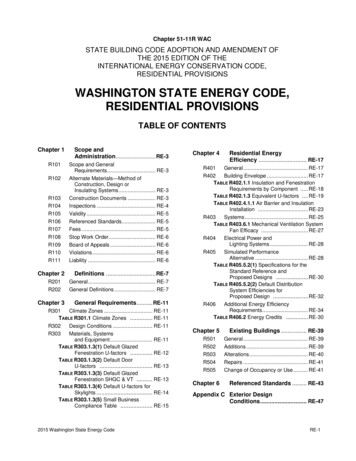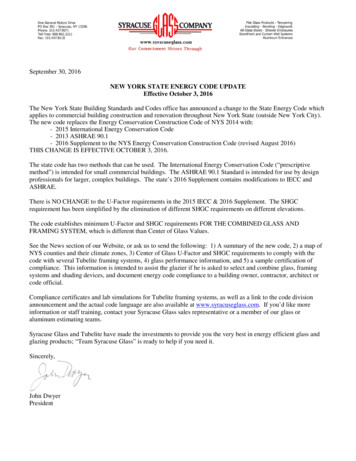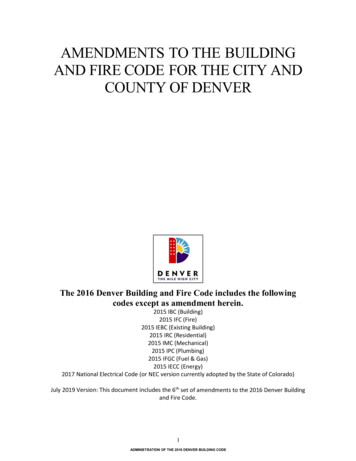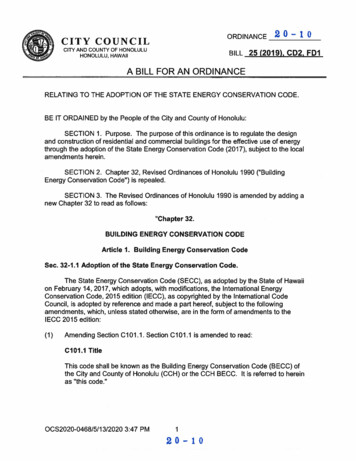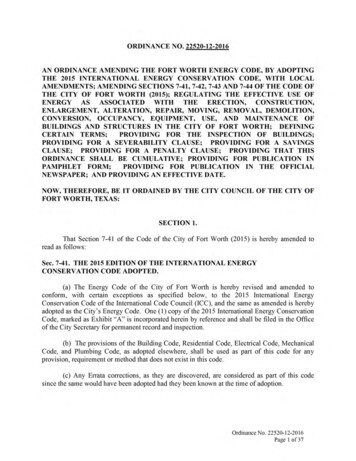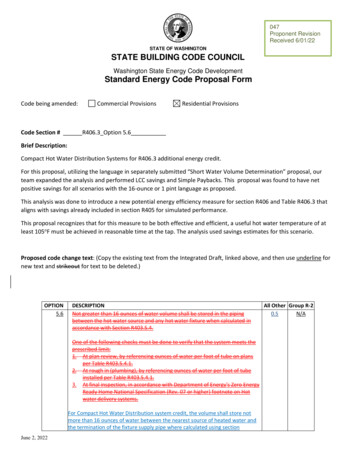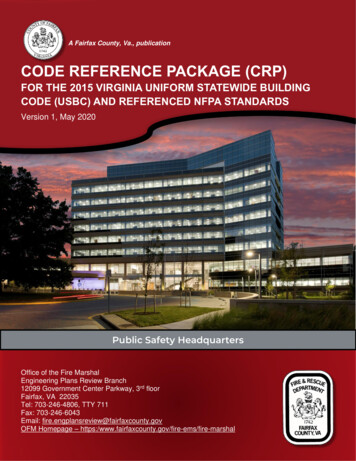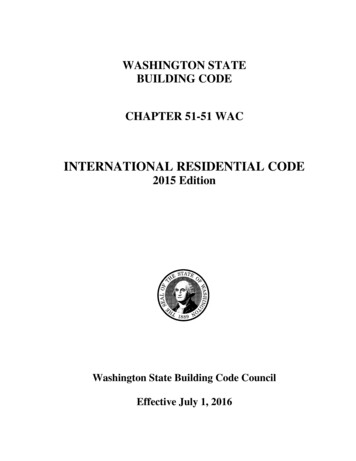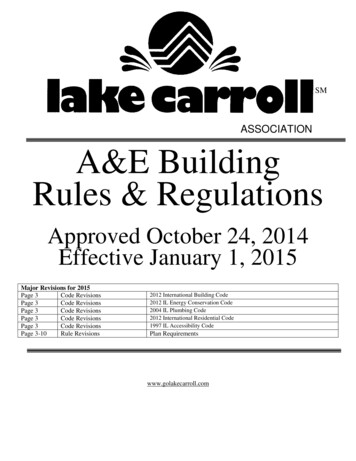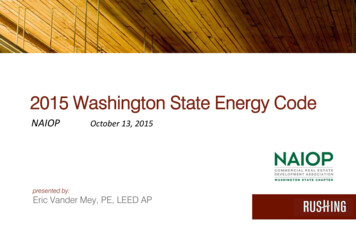
Transcription
2015 Washington State Energy CodeNAIOPOctober 13, 2015presented by:Eric Vander Mey, PE, LEED AP
Presentation OutlineTopics to Cover: Washington State Energy Code (WSEC)Process & Goals2015 WSEC Proposed Major ChangesEfficiency ImprovementPublic Comment Period Ends Friday, 10/23Upcoming Public Hearing in Olympia onFriday, 10/16DiscussionRUSHING - 2015 Washington State Energy Code (WSEC) 2
Adoption Timeline & Facts2015 WSEC Development Timeline: January, 2015: 2015 WSEC “Integrated Draft” IssuedMarch 1, 2015: Code Change Proposal ReceivedMarch-June, 2015: Energy Code TAG Review MeetingsAugust, 2015: Public Review Draft IssuedSeptember 11, 2015: Eastern WA Public Comment MeetingOctober 16, 2015: Western WA Public Comment MeetingOctober 23, 2015: Public Comment Period ClosesNovember 2015: WSBCC Issues Final DraftDecember 2015: WSBCC Issues Report to Legislature2015 Energy Code Adoption Date: July 1, 2016 (after WA Legislature Approval)RUSHING - 2015 Washington State Energy Code (WSEC) 3
Adoption Timeline & FactsFun Facts for 2015 WSEC: In Development for Past 2 Years, 12 TAG Meetings“Integrated Draft” best of 2012 WSEC & 2015 IECC 2015 IECC: Commercial: 214 Amendments 2015 IECC: Residential: 46 Amendments2015 WSEC Code Change Proposals Received 2012 WSEC: Commercial: 132 Proposals Received 2012 WSEC: Residential: 32 Proposal ReceivedCommercial Energy Code Proposals (132 Proposals) Approved: 37 Proposals Approved with Modifications: 63 Proposals Denied: 15 Proposals Withdrawn: 17 ProposalsRUSHING - 2015 Washington State Energy Code (WSEC) 4
WSEC: Goals & ProgressRCW 19.27A: Energy Related Building Standards: 19.27A.160: Residential and nonresidential construction permitted under the 2031 stateenergy code must achieve a seventy percent reduction in annual net energyconsumption, using the adopted 2006 WSEC as a baseline. Last Update 2009 19.27A.130: The legislature finds thatenergy efficiency is the cheapest,quickest, and cleanest way to meetrising energy needs, confront climatechange, and boost our economy.Change required every 3 years: 8.75% over 2006 WSEC 14% over previous code2012 WSEC vs 2009 WSEC: Residential: 6.6% Reduction Commercial: 4.8% Reduction RUSHING - 2015 Washington State Energy Code (WSEC)Chart Source: WSBCC December 2012 Legislative Report 5
WSEC: Goals & ProgressRUSHING - 2015 Washington State Energy Code (WSEC)Chart Source: WSBCC December 2012 Legislative Report 6
WSEC: Goals & ProgressRecap per July 2015 WSBCC MVE Committee Letter:3. The Council must evaluate and determine the costs and the benefitsa. The legislature finds making homes, businesses, and public institutionsmore energy efficient will save money, create good local jobs, enhanceenergy security, reduce pollution that causes global warming, and speedeconomic recovery while reducing the need to invest in costly newgenerationb. Any new measures, standards, or requirements adopted by the Councilmust be technically feasible, commercially available, and cost-effective tobuilding owners and tenants.c. The Council has adopted a definition of cost-effectiveness based RCW39.35 recommended by Department of Commerced. Executive Order 14-04 from Washington Governor Jay Inslee directs theCouncil to “achieve early and widespread deployment of energy-neutralbuildings prior to the 2031 statutory requirement in RCW 19.27A.160”RUSHING - 2015 Washington State Energy Code (WSEC)Source: WSBCC MVE Committee Letter, July 2015 7
WSEC: Goals & ProgressRecap per July 2015 WSBCC MVE Committee Letter:3. The Council must evaluate and determine the costs and the benefits, cont.e. A guide on how to evaluate cost-effectiveness is therefore defined by theCouncil as a code change that has a net present savings over a 50-year lifecycle of a building utilizing the Life Cycle Cost Tool (LCCT) as developed bythe Washington State Office of Financial Management (OFM). Themethodology of the LCCT is based on the NIST Handbook 135 methodologyand utilizes specific inputs as determined by the Council with guidance fromthe Washington State Department of Commerce.f. If the council determines that economic, technological, or process factorswould significantly impeded adoption of or compliance with incrementalprogress towards the 70 percent reduction in annual net energy consumption,the council may defer the implementation of the proposed energy codeupdate and shall report it findings to the legislature by December 31st of theyear prior to the year in which those codes would otherwise be enacted.RUSHING - 2015 Washington State Energy Code (WSEC)Source: WSBCC MVE Committee Letter, July 2015 8
Structure of WSEC and SEC2015 WSEC: Commercial “C” BuildingsResidential “R” BuildingsAppendices A, B, C, DDefinitions per IECC:RESIDENTIAL BUILDING. For this code, includes detachedone- and two-family dwellings and multiple single-familydwellings (townhouses) as well as Group R-2, R-3 and R-4buildings three stories or less in height above grade plane.COMMERCIAL BUILDING. For this code, all buildings thatare not included in the definition of "Residential buildings."RUSHING - 2015 Washington State Energy Code (WSEC) 9
2015 WSEC Proposed Major Changes2015 WSEC Commercial Change Summary: C402: Building Envelope changes C403.2.6: Ventilation changes C403.2.6.1: Dedicated Outdoor Air Systems C403.3: Economizer Cooling changes C403.2.7.1: Kitchen Exhaust Energy efficiency changes C403.5: Energy Recovery changes C404.3: Domestic Hot Water Recirculation changes C405.4: Lighting Power Density changes C405.10 Controlled Receptacles in certain occupancies C406: Additional Efficiency Package Options: 2 points C407: Energy Modeling Compliance Path changes C408: Commissioning changes C409: Energy Metering clarifications “Capable of” changed to “Configured to” in 55 locations Chapter 5: Existing Buildings new chapter Appendix E: Renewable Energy AppendixRUSHING - 2015 Washington State Energy Code (WSEC) 10
C402: Building Envelope RequirementsC402 Quick Recap Table C402.1.4: Target UA Compliance adds componentcategory for “Mass Transfer Deck Slab Edge” U-0.20 C402.2.1: Multiple layers of continuous insulation installation Table C402.4: No changes in Window Thermal Performance Table C402.4: SHGC & PF Varies by Elevation (SEW vs N) No Changes in Maximum Window-to-Wall Ratio (WWR)Paths Available C402.4.1: Standard Glazing Performance: WWR: 30% C402.4.1.3: High-Performance Glazing: WWR: 30-40% C402.5.3: Rooms containing fuel-burning appliances – newsection C402.5.7: Vestibules: Clarifications of vestibule exceptionsRUSHING - 2015 Washington State Energy Code (WSEC) 11
C403: Mechanical SystemsC403 Quick Recap Update Mechanical Equipment Efficiency Tables per 90.1-2013 “Capable of” changed to “Configured to” in 55 locations in code Temperature setpoints, deadbands, off-hour controls, etc. C403.2.4.1: Thermostatic controls for neighboring zones C403.2.4.12: Direct Digital Control Systems required for certain systems C403.2.6: Ventilation is capped at 150% of 2015 IMC Chapter 4 C403.2.6.1: Dedicated Outdoor Air Systems (DOAS) C403.2.7.1: Kitchen Exhaust Systems (Variable Volume or HeatRecovery) C403.2.11.3: Fan Efficiency Grade not less than 67 C403.3: Economizers – Removal of Simple Systems C403.5.1: Energy Recovery Ventilation Systems moved from MandatorySectionRUSHING - 2015 Washington State Energy Code (WSEC) 12
C403.2.6.1: Dedicated Outdoor Air Systems (DOAS)Quick Recap: What is a Dedicated Outdoor Air System? Ventilation is supplied independently of Space Heating and Cooling System 100% outdoor air is delivered directly to space for ventilation Energy Recovery and/or Demand Controlled Ventilation is utilized Space heating and cooling fan coils operate in Parallel with Ventilation Systemand Cycle on/off when heating or cooling is required Required in Five Building Types: Office Retail Education Libraries Fire Stations Simpler Systems than VAV Systems Airside Economizers are NOT required Space cooling loads must be 5 watt/sf or airside economizer is required Glazing: Up to 40% WWR is allowedRUSHING - 2015 Washington State Energy Code (WSEC) 13
C403.2.6.1: Dedicated Outdoor Air Systems (DOAS)Two independent systems: One system to heat and cool the building One system to ventilate the buildingRUSHING - 2015 Washington State Energy Code (WSEC) 14
C403.2.6.1: Dedicated Outdoor Air Systems (DOAS)C403.2.6.1 Dedicated outdoor air systems (DOAS). For office, retail, education,libraries and fire stations, outdoor air shall be provided to each zone by a dedicatedoutdoor air system (DOAS) which delivers 100 percent outside air without requiringoperation of the heating and cooling system fans for ventilation air delivery. TheDOAS shall include either energy recovery ventilation and/or demand control ventilation.C403.2.6.1.2 Heating/cooling system fan controls. For systems meeting therequirements of Section C403.2.6.1 dedicated outdoor air systems, equipment andcontrols shall be configured to cycle off zone heating and cooling equipment fansand/or pumps, primary cooling air, heating and cooling coils, and parallel heatingfans when there is no call for heating or cooling in the zone.C403.3 Economizers Exception 1. Systems complying with Section C403.2.6.1Dedicated outdoor air systems (DOAS) with year-round cooling loads from lights andequipment of less than 5 watts per square foot.RUSHING - 2015 Washington State Energy Code (WSEC) 15
C403.2.6.1: Dedicated Outdoor Air Systems (DOAS)C402.4.1.4 Increased vertical fenestration area with highperformance mechanical systems. The vertical fenestrationarea (not including opaque doors and opaque spandrel panels) ispermitted to exceed 30 percent but shall not exceed 40 percent ofthe gross above-grade wall area, for the purpose of prescriptivecompliance with Section C402.1.4 or for the componentperformance alternative in Section C402.1.5, provided that themechanical system complies with all requirements of SectionC403.2.6.1 Dedicated outdoor air systems (DOAS). Thisincreased glazing fraction is not permitted to be used to establishthe reference case for the Total Building Performance compliancepath in Section C407.RUSHING - 2015 Washington State Energy Code (WSEC) 16
C403.2.7.1: Kitchen Exhaust SystemsC403.2.7.1 Kitchen exhaust systems. Replacement air introduced directly into the exhausthood cavity shall not be greater than 10 percent of the hood exhaust airflow rate. Conditionedsupply air delivered to any space shall not exceed the greater of the following:1. The ventilation rate required to meet the space heating or cooling load.2. The hood exhaust flow minus the available transfer air from adjacent space whereavailable transfer air is considered that portion of outdoor ventilation air not required tosatisfy other exhaust needs, such as restrooms, and not required to maintainpressurization of adjacent spaces.RUSHING - 2015 Washington State Energy Code (WSEC) 17
C403.2.7.1: Kitchen Exhaust SystemsC403.2.7.1 Kitchen exhaust systems.Where total kitchen hood exhaust airflow rate is greater than 2,000 cfm each hood shall be afactory built commercial exhaust hood listed by a nationally recognized testing laboratory incompliance with UL 710. Each hood shall have a maximum exhaust rate as specified in TableC403.2.7.1 and shall comply with one of the following:1. Not less than 50 percent of all replacement air shall be transfer air that would otherwisebe exhausted.2. Demand ventilation systems on not less than 75 percent of the exhaust air that areconfigured to provide not less than a 50-percent reduction in exhaust and replacementair system airflow rates, including controls necessary to modulate airflow in response toappliance operation and to maintain full capture and containment of smoke, ef-fluentand combustion products during cooking and idle.3. Listed energy recovery devices with a sensible heat recovery effectiveness of not lessthan 40 percent on not less than 50 percent of the total exhaust airflow.RUSHING - 2015 Washington State Energy Code (WSEC) 18
C403.2.7.1: Kitchen Exhaust SystemsC403.2.7.1 Kitchen exhaust systems.Where a single hood, or hood section, is installed over appliances with different duty ratings,the maximum allowable flow rate for the hood or hood section shall be based on therequirements for the highest appliance duty rating under the hood or hood section.Exceptions:1. Where not less than 75 percent of all the replacement air is transfer air that wouldotherwise be exhausted.2. Certified grease extractor hoods that require a face velocity no greater than 60 fpm.RUSHING - 2015 Washington State Energy Code (WSEC) 19
C404: Service Water HeatingC404 Quick Recap C404.2.1: High input-rated service water heatingsystems ( 1,000,000 BTUH) shall have a thermalefficiency not less than 90%. C404.3: DHW piping maximum allowable pipe length orvolume to minimize piping water volume. C404.7: DHW circulation system and controlsrequirements.RUSHING - 2015 Washington State Energy Code (WSEC) 20
C405: Electrical, Power, and Lighting SystemsC405 Quick Recap C405.2.1 & C405.2.2: Occupant sensor controls and time switchcontrols sections revised. C405.4.2: Interior lighting power densities (LPD) reduced by 20%. Table C402.4.2(2): Space-by-space interior LPD correction forceiling height reinstated per footnotes d & f. C405.6: Electrical transformers clarification of efficiencies. C405.8: Electric motor efficiency requirement clarifications. C405.9: Elevator and escalator efficiency changes. C405.10: Controlled receptacles – new section.RUSHING - 2015 Washington State Energy Code (WSEC) 21
C405.5.2: Lighting Power DensitySection C405.5.2:Lighting power densities reduced by 20% from 2012 WSEC allowances.RUSHING - 2015 Washington State Energy Code (WSEC) 22
C406: Additional Efficiency Package OptionsC406 Quick Recap 2015 WSEC: Pick Two of the Eight Options Each option is worth 3% or more of a building energy usage C406 was NOT adopted for the 2012 WSEC or 2012 SEC Differences from 2015 IECC 2015 IECC only required to do One of the Six Options 2015 WSEC modifies the options to make them more stringent 2015 WSEC requires two optionsRUSHING - 2015 Washington State Energy Code (WSEC) 23
C406: Additional Efficiency Package OptionsC406.1 Requirements. Buildings shall comply with no less than two of thefollowing:1. More efficient HVAC performance in accordance with Section C406.2.2. Reduced lighting power in accordance with Section C406.3.3. Enhanced lighting controls in accordance with Section C406.4.4. On-site supply of renewable energy in accordance with Section C406.5.5. Provision of a dedicated outdoor air system for certain HVAC equipment inaccordance with Section C406.6.6. High-efficiency service water heating in accordance with Section C406.7.7. Enhanced envelope performance in accordance with Section C406.8.8. Reduced air infiltration in accordance with Section C406.9.C406.1.1 Tenant spaces. Tenant spaces shall comply with Section C406.2,C406.3, C406.4, or C406.7, where applicable. Where an entire building complieswith Section C406.5, C406.8 or C406.9, tenant spaces within the building shall bedeemed to comply with this section.RUSHING - 2015 Washington State Energy Code (WSEC) 24
C406.2: HVAC OptionSection C406.2: HVAC option.C406.2 More efficient HVAC equipment and fan performance. Buildings shallcomply with Sections C406.2.1 through C406.2.3.C406.2.1 HVAC system selection. No less than 90 percent of the total HVAC capacityserving the building shall be provided by equipment that is listed in Tables C403.2.3(1)through C403.2.3(9) or a combination thereof.C406.2.2 Minimum equipment efficiency. Equipment shall exceed the minimumefficiency requirements listed in Tables C403.2.3(1) through C403.2.3(7) by 15 percent,in addition to the requirements of Section C403. Where multiple performancerequirements are provided, the equipment shall exceed all requirements by 15 percent.C406.2.3 Minimum fan efficiency. Stand-alone supply, return and exhaust fansdesigned for operating with motors over 750 watts (1 hp) shall have an energyefficiency classification of not less than FEG 71 as defined in AMCA 205. The totalefficiency of the fan at the design point of operation shall be within 10 percentage pointsof either the maximum total efficiency of the fan or the static efficiency of the fan.RUSHING - 2015 Washington State Energy Code (WSEC) 25
C406.3: Lighting Power Density OptionSection C406.3: LPA option.C406.3 Reduced lighting power. Buildings shall comply with Sections C406.3.1 and,where applicable, C406.3.2.C406.3.1 Reduced lighting power density. The total interior lighting power (watts) ofthe building shall be determined by using 75 percent of the lighting power valuesspecified in Table C405.4.2(1) times the floor area for the building types, or by using 75percent of the interior lighting power allowance calculated by the Space-by-SpaceMethod in Section C405.4.2.C406.3.2 Lamp fraction. Not less than 95 percent of the interior lighting power (watts)from lamps in permanently installed light fixtures in dwelling units and sleeping unitsshall be provided by lamps with a minimum efficacy of 60 lumens per watt.RUSHING - 2015 Washington State Energy Code (WSEC) 26
C406.3: Lighting Power Density OptionSection C406.3: LPA option.By using 75 percent of the interior lighting power allowance calculated by theSpace-by-Space Method in Section C405.4.2.RUSHING - 2015 Washington State Energy Code (WSEC) 27
C406.4: Lighting Controls OptionsSection C406.4: Lighting controls option.C406.4 Enhanced digital lighting controls. Interior lighting shall be located,scheduled and operated in accordance with Section C405.2.2 and no less than 90percent of the total installed interior lighting power shall be configured with the followingenhanced control functions.1. Luminaires shall be configured for continuous dimming.2. Each luminaire shall be individually addressed.RUSHING - 2015 Washington State Energy Code (WSEC) 28
C406.5: On-Site Renewable Energy OptionSection C406.5: On-site renewable energy option.C406.5 On-site renewable energy. Buildings shall be provided with on-site renewableenergy systems with a total system rating per square foot of conditioned floor area ofthe building of not less than the value specified in Table C406.5.Note: Table is per 8/7/2015Errata to CR102 filed rule.RUSHING - 2015 Washington State Energy Code (WSEC) 29
C406.5: On-Site Renewable Energy OptionExample 1: PV Array for: 5-story 150,000 SF Office Building with 10,000 SF of RetailRUSHING - 2015 Washington State Energy Code (WSEC) 30
C406.5: On-Site Renewable Energy OptionExample 2: PV Array for: 10-story 300,000 SF Office Building with 10,000 SF of RetailRUSHING - 2015 Washington State Energy Code (WSEC) 31
C406.6: DOAS OptionSection C406.6: DOAS option.C406.6 Dedicated outdoor air system (DOAS). For buildings not subject to theprovisions of Section C403.2.6.1, provide DOAS in accordance with SectionC403.2.6.1.RUSHING - 2015 Washington State Energy Code (WSEC) 32
C406.7: Service Water Heating OptionSection C406.7: Service water heating option.C406.7 Reduced energy use in service water heating. Buildings shall comply withSections C406.7.7 and C406.7.2.C406.7.1 Building type. Not less than 90 percent of the conditioned floor area shall beof the following types:1. Group R-1: Boarding houses, hotels or motels.2. Group I-2: Hospitals, psychiatric hospitals and nursing homes.3. Group A-2: Restaurants and banquet halls or buildings containing foodpreparation areas.4. Group F: Laundries.5. Group R-2: Buildings with residential occupancies.6. Group A-3: Health clubs and spas.7. Buildings with a service hot water load of 10 percent or more of total buildingenergy loads, as shown with an energy analysis as described in Section C407.RUSHING - 2015 Washington State Energy Code (WSEC) 33
C406.7: Service Water Heating OptionSection C406.7: Service water heating option.C406.7.1 Load fraction. Not less than 60 percent of the annual building service hotwater energy use, or not less than 100 percent of the annual building service hot waterheating energy use in buildings subject to the requirements of Section C403.6.4, shallbe provided by one or more of the following:1. Service hot water system delivering heating requirements using heat pumptechnology with a minimum COP of 3.0.2. Waste heat recovery from service hot water, heat recovery chillers, buildingequipment, process equipment, a combined heat and power system, or otherapproved system.3. Solar water-heating systems.RUSHING - 2015 Washington State Energy Code (WSEC) 34
C406.8: Envelope OptionSection C406.8—Envelope option.C406.8 Enhanced envelope performance. The total UA ofthe building thermal envelope shall be 15 percent lower thanthe maximum allowable UA for a building of identicalconfiguration and fenestration area in accordance withSection C402.1.4, where UA equals the sum of the U-valuesof each distinct envelope assembly multiplied by the area insquare feet of that assembly.RUSHING - 2015 Washington State Energy Code (WSEC) 35
C406.9: Air Infiltration OptionSection C406.9—Air infiltration option.C406.9 Reduced air infiltration. Air infiltration shall be verified by whole buildingpressurization testing conducted in accordance with ASTM E779 or ASTM E1827 byan independent third party. The measured air leakage rate of the building envelopeshall not exceed 0.25 cfm/ft2 (2.0 L/s m2) under a pressure differential of 0.3 in.water (75 Pa), with the calculated surface area being the sum of the above and belowgrade building envelope. A report that includes the tested surface area, floor area, airby volume, stories above grade, and leakage rates shall be submitted to the codeofficial and the building owner.Exception: Where the conditioned floor area of the building is not less than250,000 ft2 (25,000 m2), air leakage testing shall be permitted to be conductedon representative above grade sections of the building provided the conditionedfloor area of tested areas is no less than 25 percent of the conditioned floor areaof the building and are tested in accordance with this sectionRUSHING - 2015 Washington State Energy Code (WSEC) 36
C407: Total Building Performance (TBP)C407 Quick Recap C401.2: Proposed building energy consumption shall be equal to orless than 87% of the standard reference design building. When complying with C407 compliance with C406 is NOT required. Compliance with C404 is mandatory therefore required to comply withC404.2.1: High input-rated service water heating systems ( 1,000,000BTUH) shall have a thermal efficiency not less than 90%. Table C407.5.1(1): Air infiltration requirements clarified. Table C407.5.1(1): Outdoor airflow rates requirements clarified. Table C407.5.1(1): DOAS fan system requirements added. Table C407.5.1(1): Service Water Heat Recovery Factor (SWHF)correction for proposed building IECC language is not adopted. Table C407.5.1(2): DOAS fan system are the baseline for (5) buildingtypes where DOAS is the prescriptive system. Table C407.5.1(4): DOAS fan system requirements added.RUSHING - 2015 Washington State Energy Code (WSEC) 37
C408: CommissioningC408 Quick Recap 408.1: A building commissioning process led by a certifiedcommissioning professional shall be completed Figure C408.1.4.2: Commissioning Compliance Checklist revised. C408.2: Mechanical systems under 20 tons or 300 MBH excluded. C408.3: Lighting system commissioning requirements revised.CERTIFIED COMMISSIONING PROFESSIONAL. An individual who is certified by anANSI/ISO/IEC 17024:2012 accredited organization to lead, plan, coordinate andmanage commissioning teams and implement commissioning processes. Theindividual's accredited certification required by the referenced standard provides ameasured level of experience and competence with the various whole buildingcommissioning processes and ability to deliver quality service. The engineer of recordfor the project may be considered the certified commissioning professional if she/he isqualified to perform commissioning services for the entire process.RUSHING - 2015 Washington State Energy Code (WSEC) 38
C409: Energy MeteringC409 Quick Recap C409.1: Clarified when small tenant spaces are exempt.RUSHING - 2015 Washington State Energy Code (WSEC) 39
C501: Existing BuildingsC501 Quick Recap New chapter to consolidate requirements for alteration,repair, addition and change of occupancy of existingbuildings and structures.RUSHING - 2015 Washington State Energy Code (WSEC) 40
CR-102 Proposed Rule & Public Comment ProcessRUSHING - 2015 Washington State Energy Code (WSEC) 41
CR-102 Proposed Rule & Public Comment ProcessRUSHING - 2015 Washington State Energy Code (WSEC) 42
ASHRAE 90.1-2004 vs 90.1-2007RUSHING - 2015 Washington State Energy Code (WSEC)Chart Source: US DOE & PNNL May 2011 Report 43
2012 WSEC vs Federal Energy CodeCommercial Buildings: ASHRAE 90.1-2010 Per DOE Final Determination QuantitativeAnalysis Report the 2010 edition of ASHRAE90.1 produces buildings that are 18.5% moreefficient (site EUI) than were required by the2007 edition. WSBCC December 2013 Legislative Reportindicates that the 2012 WSEC will fall short ofthis federal target for commercial constructionby 1 or 2%.RUSHING - 2015 Washington State Energy Code (WSEC)Source: US DOE & PNNL October 2011 Report 44
ASHRAE 90.1-2007 vs 90.1-2010RUSHING - 2015 Washington State Energy Code (WSEC)Chart Source: US DOE & PNNL October 2011 Report 45
2012 WSEC Cost Benefit ReportCommercial Primary Prototype Buildings:.RUSHING - 2015 Washington State Energy Code (WSEC)Chart Source: 2012 WSEC Cost & Savings Analysis Draft Report 46
2012 IECC vs 2015 IECCCommercial Buildings: 2015 IECC Per DOE and PNNL Energy and Energy CostSavings Analysis of the 2015 IECC forCommercial Buildings Report commercialbuildings built under 2015 IECC are11.1% more efficient (site EUI) than wererequired by the 2012 IECC edition. Analysis is for the 16 building prototypes for thecommercial code.RUSHING - 2015 Washington State Energy Code (WSEC)Source: US DOE & PNNL August 2015 Report 47
2012 IECC vs 2015 IECCRUSHING - 2015 Washington State Energy Code (WSEC)Chart Source: US DOE & PNNL August 2015 Report 48
2012 IECC vs 2015 IECCRUSHING - 2015 Washington State Energy Code (WSEC)Chart Source: US DOE & PNNL August 2015 Report 49
ASHRAE 90.1-2010 vs 90.1-2013Commercial Buildings: ASHRAE 90.1-2013 Per DOE Final Determination QuantitativeAnalysis Report the 2013 edition of ASHRAE90.1 produces buildings that are 7.6% moreefficient (site EUI) than were required by the2010 edition.2015 WSEC vs ASHRAE 90.1-2013 is yet to bedeterminedState certifications for Standard 90.1-2013 must besubmitted by September 26, 2016.RUSHING - 2015 Washington State Energy Code (WSEC)Source: US DOE August 2014 Report 50
ASHRAE 90.1-2010 vs 90.1-2013RUSHING - 2015 Washington State Energy Code (WSEC)Chart Source: US DOE August 2014 Report 51
ASHRAE 90.1-2010 vs 90.1-2013RUSHING - 2015 Washington State Energy Code (WSEC)Chart Source: US DOE August 2014 Report 52
ASHRAE 90.1-2013 vs 2015 IECCASHRAE 90.1-2013RUSHING - 2015 Washington State Energy Code (WSEC)2015 IECCChart Source: US DOE August 2014 Report 53
Other ResourcesEnergy Code Resources: Washington State Building Code Council Washington Governor Jay Inslee Executive Order 14-04 gy-Efficiency-Building-Strategy-Update-2014.pdfUS DOE Building Energy Codes Status of State Energy Code Adoption /overview/Washington State Department of Commerce http://www.neec.net/Seattle DPD west Energy Efficiency Council ttps://fortress.wa.gov/ga/apps/SBCC/Page.aspx?cid ?nid -code-adoptionUS DOE 90.1 Determinations https://www.energycodes.gov/determinationsRUSHING - 2015 Washington State Energy Code (WSEC) 54
MEP EngineeringEnergy ModelingSustainability ConsultingLighting DesignCommissioningwww.rushingco.com
Thank YouEric Vander MeyDirector, Principalericv@rushingco.comRUSHING - 2015 Washington State Energy Code (WSEC) 56
Seattle Energy Code: Goals & ProgressSeattle Green Building Program & Climate Action Plan: Resolution 30280: Date Adopted: February 12, 2001 These proposed amendments should seek to achieve up to 20% enhancedenergy efficiency beyond the current version of ASHRAE/IESNA Standard 90.1.Resolution 31312: Date Adopted: October 3, 2011 Seattle will strive to reach net zero greenhouse gas (GHG) emissions by 2050 Energy Reduction in Buildings: 2020 Targets Residential: -8% reduction in energy use Commercial: -5% reduction in energy use Both: -15% reduction in tonnes of CO2 equivalent (CO2e) per billon BTU Energy Reduction in Buildings: 2030 Targets Residential: -20% reduction in energy use Commercial: -10% reduction in energy use Both: -25% reduction in tonnes of CO2 equivalent (CO2e) per billon BTURUSHING - 2015 Washington State Energy Code (WSEC) 57
RUSHING - 2015 Washington State Energy Code ( WSEC) 10. 2015 WSEC Proposed Major Changes. 2015 WSEC Commercial Change Summary: C402: Building Envelope changes C403.2.6: Ventilation changes C403.2.6.1: Dedicated Outdoor Air Systems C403.3: Economizer Cooling changes C403.2.7.1: Kitchen Exhaust Energy efficiency changes
